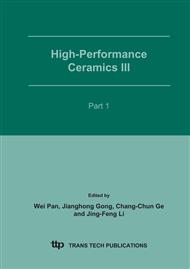p.1421
p.1425
p.1429
p.1433
p.1437
p.1441
p.1445
p.1449
p.1453
Effect of Pressure on TiB2-Cu Composite via In-Situ Reaction Synthesis
Abstract:
TiB2-Cu matrix composites from titanium, boron and copper powders were in-situ fabricated by exothermic reaction. The effect of the applied pressure on the mechanical properties of the composite was investigated. The results showed that when the applied pressure increasing, the relative density, bending strength, fracture toughness and hardness of the composites were on the increase due to the formation of fine microstructure and the improvement of densification with the pressure increasing. The high pressure is beneficial to the better mechanical properties.
Info:
Periodical:
Pages:
1437-1440
Citation:
Online since:
February 2007
Authors:
Keywords:
Price:
Сopyright:
© 2005 Trans Tech Publications Ltd. All Rights Reserved
Share:
Citation:


